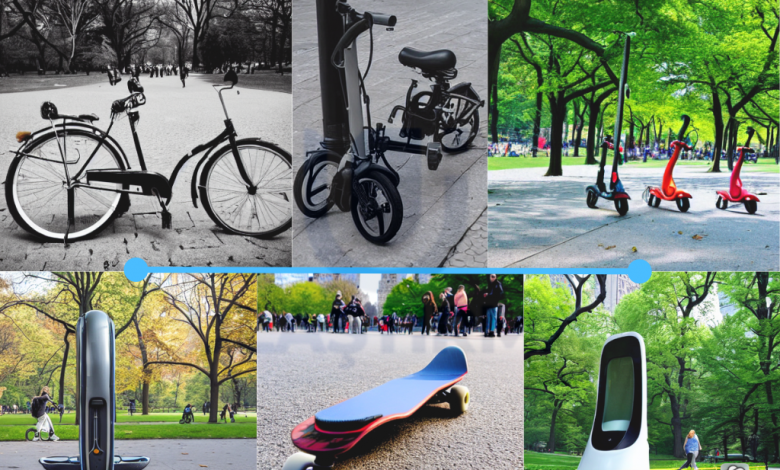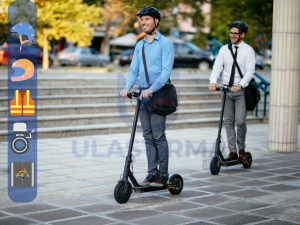Micro Mobility Technologies
Urban Micro Mobility Devices / Vehicles

How it started?
The concept of micro mobility, or the use of small, lightweight modes of transportation for short trips, has been around for many years. However, the term “micro mobility” itself has only recently come into widespread use.
One of the earliest forms of micro mobility was the bicycle, which has been around since the 19th century and has long been used as a convenient and environmentally friendly way to get around in urban areas. Other early forms of micro mobility included skateboards, rollerblades, and other small, lightweight vehicles that could be used for short trips.
In recent years, micro mobility has seen a resurgence in popularity, driven in part by the rise of ride-sharing apps and the increasing focus on reducing traffic congestion and air pollution in cities. This has led to the development of new micro mobility devices, such as electric scooters and bikes, which have become increasingly popular in urban areas around the world.
Overall, the history of micro mobility is closely tied to the development of urban transportation and the search for convenient, efficient, and environmentally friendly ways to get around in cities. As cities continue to evolve and change, it’s likely that micro mobility will continue to play an important role in the way that people get around.
What is Micro Mobility?
Micro mobility refers to small, lightweight modes of transportation that are designed for short trips. These can include electric scooters, electric bikes, and other similar vehicles. The goal of micro mobility is to provide an easy, convenient, and environmentally friendly way for people to get around in urban areas, particularly for short trips that may be too far to walk but too short to justify driving a car. Some examples of micro mobility services include Martı, Bin Bin, Lime and Bird, which allow users to rent electric scooters through a mobile app.
Micromobility Around the World
Micro mobility has gained popularity around the world in recent years as a convenient and eco-friendly way to get around urban areas. In many cities, electric scooters and bikes can be rented through a mobile app, making it easy for people to pick up and drop off the vehicles at their convenience. Some micro mobility services, such as Jump, also offer electric bikes that can be used for short trips.
There are a few different factors that have contributed to the growth of micro mobility around the world. One of the main drivers has been the rise of ride-sharing apps, which have made it easier for people to find and use alternative modes of transportation. In addition, concerns about traffic congestion and air pollution in cities have led to a greater focus on finding ways to reduce the number of cars on the road. Micro mobility services offer a way to do this, as they provide an alternative to driving that is often quicker and more convenient for short trips.
Micro mobility has not been without its challenges, however. In some cities, the sudden proliferation of electric scooters and bikes has led to concerns about safety and the need for better regulation. There have also been debates about where these vehicles should be allowed to operate and park, and how to ensure that they are used responsibly. Despite these challenges, micro mobility continues to grow in popularity and is likely to play an increasingly important role in the future of urban transportation.
Micro Mobility Devices
Micro mobility devices are small, lightweight modes of transportation that are designed for short trips. These can include electric scooters, electric bikes, and other similar vehicles. The goal of micro mobility is to provide an easy, convenient, and environmentally friendly way for people to get around in urban areas, particularly for short trips that may be too far to walk but too short to justify driving a car.
Some examples of micro mobility devices include:
- Electric scooters: These are small, lightweight scooters that are powered by an electric motor. They are usually designed for use on sidewalks and bike lanes, and can be a convenient way to get around for short trips.
- Electric bikes: These are bicycles that are powered by an electric motor, which can assist the rider when pedaling. Electric bikes can be a good option for people who want to get some exercise, but may not be able to pedal a regular bike for long distances.
- E-skateboards: These are skateboards that are powered by an electric motor, and can be a fun and convenient way to get around for short trips.
- E-skates: These are small, lightweight skateboards that are worn on the feet and powered by an electric motor. They can be a convenient option for people who want to get around quickly and easily for short distances.
There are many other types of micro mobility devices as well, and new ones are being developed all the time. The specific devices available can vary depending on the location.
Traffic Rules for Micro Mobility
Traffic rules for micro mobility devices, such as electric scooters and bikes, can vary depending on the location. In general, these devices are subject to many of the same rules as other vehicles on the road. This can include rules about where they are allowed to operate, how fast they can go, and whether or not they are required to follow traffic signals.
In some cases, micro mobility devices may be treated differently from other vehicles. For example, they may be allowed to operate on sidewalks or bike lanes, rather than on the road with other vehicles. In other cases, they may be subject to specific rules that are designed to ensure the safety of their users and others on the road.
It’s important for users of micro mobility devices to familiarize themselves with the traffic rules in their area, and to follow them at all times when operating the devices. This can help to prevent accidents and ensure the safe and responsible use of these devices.
Are e-Cars a kind of Micro Mobility Devices?
An electric car is generally not considered a micro mobility device. Micro mobility devices are typically small, lightweight modes of transportation that are designed for short trips in urban areas. They can include electric scooters, electric bikes, and other similar vehicles. Electric cars, on the other hand, are typically larger and more expensive than micro mobility devices, and are designed for longer trips.
That being said, electric cars can certainly be a part of the broader category of micro mobility, as they offer an environmentally friendly alternative to traditional gasoline-powered cars for getting around in urban areas. Electric cars can help to reduce traffic congestion and air pollution in cities, and can be a convenient and efficient way to get around for longer trips. However, they are generally not as lightweight or as convenient as some other micro mobility devices, such as electric scooters or bikes, which are easier to use for very short trips.
